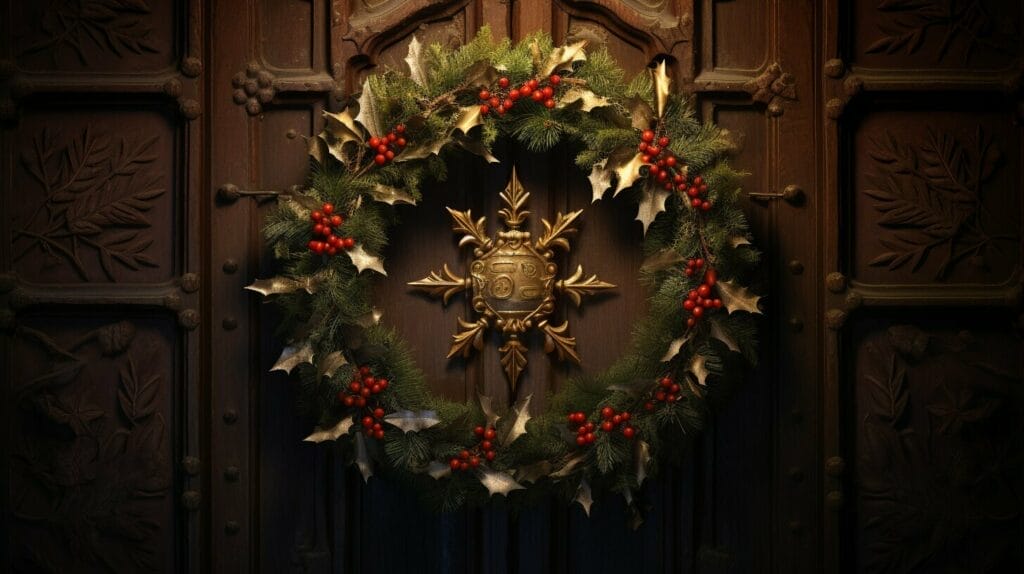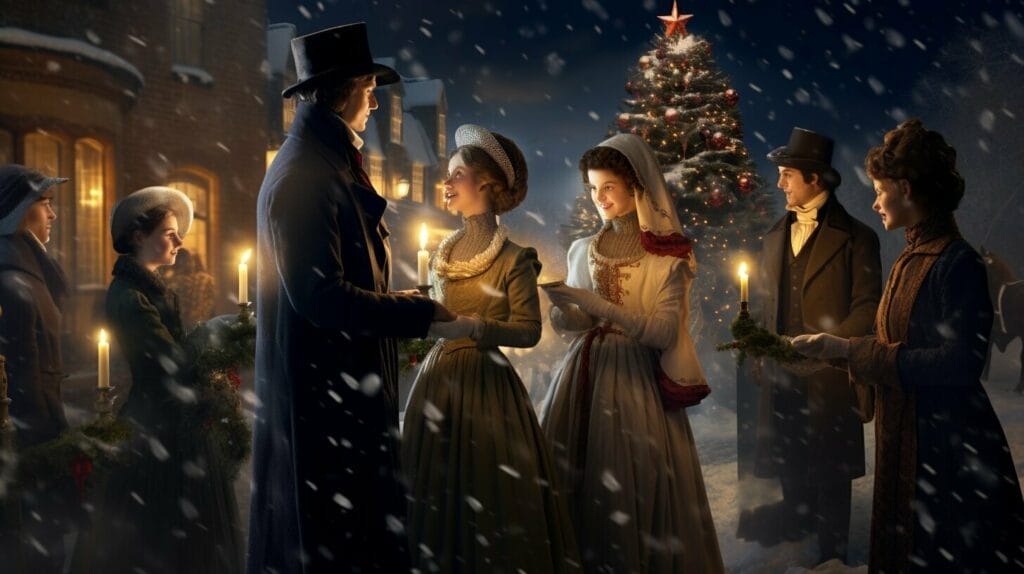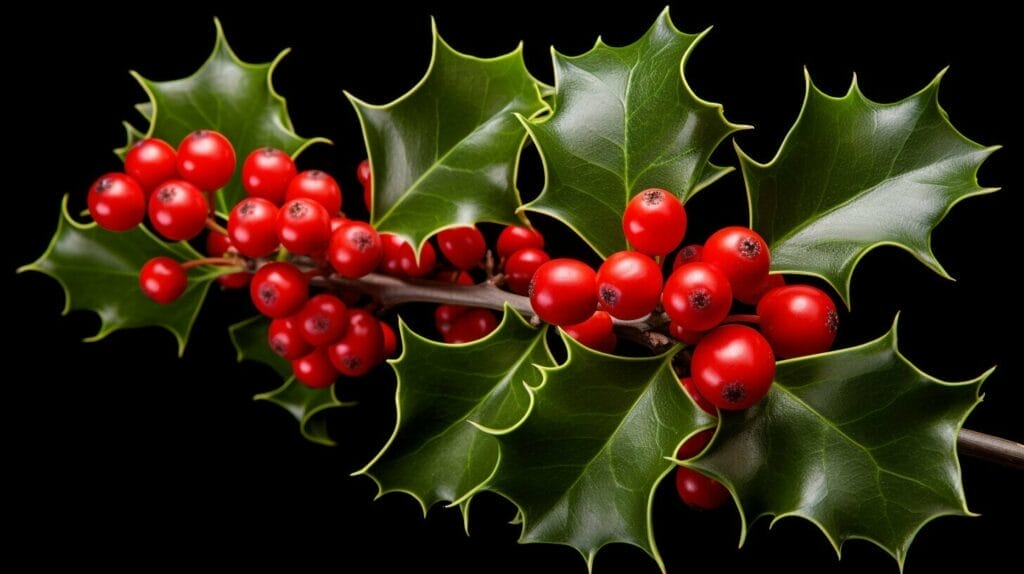Christmas Holly History and Its Symbolism: Secrets and Myths
During the holiday season, you can see holly adorning homes, shops, and public spaces. Its deep green leaves and bright red berries make it a favorite choice for festive decorations. But did you know that holly has a rich history and symbolism, dating back to ancient pagan traditions? In this article, we explore the fascinating history of Christmas holly and its importance in modern-day celebrations.

Key Takeaways:
- Holly has ancient pagan roots and was associated with the winter solstice.
- The druids of ancient Britain believed that holly had protective powers.
- Holly was revered during the Roman festival of Saturnalia.
- Holly is commonly used in Christmas decorations and is often paired with the Christmas tree.
- Holly has played a significant role in Christmas traditions around the world for centuries.
The Pagan Roots of Christmas Holly: Holly and the Winter Solstice
You may have grown up seeing holly adorning homes and Christmas trees during the holidays, but did you know that this tradition actually has its roots in ancient pagan celebrations?
Christmas holly history has deep roots in pagan cultures. For ancient pagans, holly was a sacred plant that represented the male and female principles of nature. It was associated with the winter solstice, a time when darkness prevailed, and the sun was reborn.

The winter solstice, which is the shortest day and longest night of the year, has been celebrated by various cultures throughout history. For the druids, a priestly class in ancient Celtic societies, holly was a symbol of eternal life and rebirth. They believed that holly had magical powers and would hang it in their homes to ward off evil spirits and bring good luck during the winter solstice.
In ancient Rome, the winter solstice was celebrated during the Saturnalia festival, which lasted for seven days from December 17th to December 23rd. During this time, holly was used to decorate homes and public spaces as a symbol of goodwill and the continuation of life. The Romans also believed that holly had healing powers and would use it in their medicine. The Roman tradition of decking homes with holly and other greenery during Saturnalia was eventually assimilated into Christian Christmas celebrations.
Over the centuries, holly has been incorporated into Christmas traditions around the world. It is commonly used in wreaths, garlands, and other decorative elements, and is often paired with the Christmas tree. Holly’s association with eternal life and rebirth made it a fitting decoration for Christmas, which celebrates the birth of Jesus Christ.
In addition to its use in decorations, holly has also been used in various other ways during Christmas celebrations. For example, in some parts of Europe, it is traditional to place a sprig of holly in the bed of a newborn baby to bring them good luck throughout their life.
Today, holly continues to be a prominent symbol of the Christmas season, and its pagan roots are still recognized and celebrated by some. Whether you incorporate holly into your decorations or simply enjoy its beauty from afar, you can appreciate the rich history and symbolism behind this beloved holiday plant.
Holly in Decorations: Wreaths and Yuletide Decor
As the Christmas season approaches, it’s hard to miss the significant presence of holly in decorations. Holly’s bright red berries and distinctive green foliage have been popular Christmas decorations for centuries. Traditionally holly wreaths, garlands, and yuletide decor have been used to adorn homes, churches, and public places around the world.

One of the most popular uses of holly during Christmas is the holly wreath. These wreaths are typically made with holly branches, berries, and other festive elements, such as pine cones, ribbon, and ornaments.
In addition to being a visual centerpiece for Christmas decor, holly wreaths also carry symbolic significance. The circular shape of the wreath is thought to represent the cycle of life, while the holly itself is seen as a symbol of eternal life. The berries also represent the blood of Christ, further emphasizing the Christian roots of the holiday.
Another popular use of holly in yuletide decor is as a garland or swag. These pieces can be draped over mantels, windowsills, or banisters to add a festive touch to any space. Some people even use holly branches to embellish their Christmas tree, using it as a natural, yet decorative, alternative to tinsel or garland.
In Victorian times, holly was often used as part of the floral arrangements and decorations in homes during Christmas. It was especially popular in England and has since been adopted around the world. Holly’s deep green leaves and vivid red berries were a perfect match for the Victorian love of elegance and excess.
Today, holly decorations can be found in many different forms, from traditional wreaths and garlands to more contemporary arrangements like centerpieces or table settings. No matter what form it takes, holly remains an evergreen symbol of the Christmas season and a festive addition to any home.
Holly and the Christmas Tree: A Timeless Pairing
Holly has long been a companion to the Christmas tree, used to add a touch of natural beauty and color to the evergreen’s branches. In fact, holly and the Christmas tree share a common history, both having been incorporated into holiday celebrations through the ages.
In medieval times, holly was used to decorate homes during the Christmas season. The bright red berries and vibrant green leaves symbolized the renewal of life and the hope of spring’s return. Holly was also believed to ward off evil spirits and protect the home from harm.
By the Victorian era, holly had become a popular decorative element during the Christmas season. It was often paired with the Christmas tree, providing a natural contrast to the tree’s synthetic ornaments. Holly was also used to create wreaths and garlands, adding a touch of nature to holiday decor.

Holly’s enduring relationship with the Christmas tree continues to this day. Many families still incorporate holly into their holiday decorations, using it to add a pop of color and texture to their trees. Some even choose to decorate their tree entirely with holly branches and berries, creating a stunning display of natural beauty.
As you gather around the Christmas tree this holiday season, take a moment to appreciate the timeless pairing of holly and the evergreen. Together, they symbolize the hope, renewal, and joy that the Christmas season brings.
Holly in Medieval Times: Festive Traditions and Beliefs
During medieval times, holly was highly valued for its unique properties and was commonly used in festive traditions. The plant was believed to ward off evil spirits and was often used in protective rituals.
Holly was also a symbol of fertility and eternal life, making it a popular choice for holiday decorations. Its vibrant green leaves and vibrant red berries were thought to represent the promise of new life and the renewal of the year.
The use of holly during the Christmas season can be traced back to medieval times, where it was incorporated into a variety of celebratory customs and practices. In some areas, holly was hung over doorways and windows to protect homes from evil spirits, while in others, it was used to decorate Christmas trees.

The popularity of holly continued to grow throughout the medieval period, and it became a familiar sight in churches and homes during the holiday season. Holly wreaths were used to adorn doors and mantels, and holly branches were hung throughout homes to bring good luck and prosperity throughout the new year.
The Importance of Holly in Medieval Folklore
In medieval folklore, holly was believed to have powerful protective properties. It was thought that placing holly leaves under one’s pillow could protect against nightmares, while carrying holly berries could bring good luck.
According to some beliefs, holly was thought to have magical properties that could ward off evil spirits and protect against lightning strikes. It was also believed that holly was a symbol of hope and resurrection, making it a popular choice for religious rituals and ceremonies.
When we think of Christmas traditions, holly is one of the first plants that comes to mind. However, many people may not know that the use of holly during Christmas celebrations has its roots in ancient Roman culture.
The Romans believed that holly had protective powers and used it to decorate their homes during the winter solstice. They also associated holly with the god Saturn, who was celebrated during the festival of Saturnalia. During this festival, which was held in December, Romans would exchange gifts and decorate their homes with holly leaves and berries.

Holly in Various Cultures
While holly has strong ties to Roman traditions, it has also been used in various other cultures throughout history. In some Celtic traditions, holly was viewed as a symbol of fertility and was believed to ward off evil spirits. Druids also considered holly to be sacred and used it in their winter solstice celebrations.
In European folklore, holly was associated with the New Year and was believed to bring good luck and prosperity. In some cultures, it was also believed that holly could protect against witches and other malevolent beings.
If you’re a fan of classic Christmas imagery, you can thank the Victorians for bringing holly back into the holiday spotlight. During the 19th century, holly made a resurgence in popularity thanks to its association with Victorian Christmas traditions.
Victorians loved to deck their halls with boughs of holly, often using it to adorn their homes and churches during the holiday season. Holly was also a popular motif in Christmas carols and holiday cards, featuring prominently in festive imagery.

The Victorians believed that holly represented the male and female aspects of nature, with its sharp leaves symbolizing the masculine and its vibrant red berries representing the feminine. The plant was also associated with good luck and protection, making it a popular addition to holiday decor.
One famous Victorian tradition was the Holly and Ivy ceremony, where holly and ivy were woven into a wreath and hung in the church in honor of the Christmas season. This ceremony was often accompanied by carols and festive celebrations.
Today, holly is still a beloved symbol of Christmas, often appearing in decorations, holiday cards, and even on festive clothing. The plant’s bright red berries and glossy, green leaves continue to evoke the spirit of the season and remind us of Christmas traditions past.
While holly has been an integral part of Christmas traditions in many countries, its significance can vary based on cultural and regional differences. European holly, also known as Ilex aquifolium, is native to the region and has been used in Christian and pre-Christian celebrations throughout the continent.
In Scandinavia, holly is associated with the Norse god Thor and was believed to protect against lightning strikes. It is also used in traditional Christmas decorations and in the making of Advent wreaths. In Germany, holly is used to decorate homes for Christmas and is believed to bring good luck and drive away evil spirits.

In Italy, holly is called “aglio” and is considered a symbol of fertility and rebirth. It is often used in nativity scenes and is associated with the birth of Jesus. In Spain and Portugal, holly is known as “acebo” and is used in Christmas decorations and to make wreaths for the Dia de los Santos Inocentes (Day of the Holy Innocents).
In the United States, holly has been an important part of Christmas celebrations since colonial times. It is often used in wreaths, garlands, and other decorations. Holly berries are also a popular addition to holiday floral arrangements. In Native American traditions, holly was believed to have protective powers and was used to ward off negative energy.
As holly continues to be an important symbol of Christmas, it is fascinating to observe the cultural variations and unique traditions surrounding this timeless plant.
Holly in Literature: Symbolism and Imagery
Holly has been used throughout literature to convey the spirit of the holiday season. Its vibrant green leaves and bright red berries are often seen as a symbol of hope and joy.
One of the most notable mentions of holly in literature is in Charles Dickens’ classic, “A Christmas Carol.” In the story, holly is used to represent the transformation of the main character, Ebenezer Scrooge, from a miserly and selfish man to a generous and kind-hearted individual.
“The walls and ceiling were so hung with living green, that it looked a perfect grove; from every part of which, bright gleaming berries glistened. The crisp leaves of holly, mistletoe, and ivy reflected back the light, as if so many little mirrors had been scattered there; and such a mighty blaze went roaring up the chimney, as that dull petrification of a hearth had never known in Scrooge’s time, or Marley’s, or for many and many a winter season gone. Heaped up on the floor, to form a kind of throne, were turkeys, geese, game, poultry, brawn, great joints of meat, sucking-pigs, long wreaths of sausages, mince-pies, plum-puddings, barrels of oysters, red-hot chestnuts, cherry-cheeked apples, juicy oranges, luscious pears, immense twelfth-cakes, and seething bowls of punch, that made the chamber dim with their delicious steam. In easy state upon this couch, there sat a jolly Giant, glorious to see: who bore a glowing torch, in shape not unlike Plenty’s horn, and held it up, high up, to shed its light on Scrooge, as he came peeping round the door.”
In addition to its association with Christmas cheer, holly is also used in literature to represent protection and warding off evil. In Sir Gawain and the Green Knight, Gawain carries a shield with a holly branch painted on it as a symbol of protection against harm.
Overall, the use of holly in literature underscores its enduring symbolism and importance in the holiday season.

Throughout history, holly has been surrounded by myths and folklore, imbuing this festive plant with symbolic significance. Let’s explore the legends and superstitions that have been passed down through generations regarding holly and its mystical properties.
The Holly King and Oak King
In ancient mythology, holly was associated with the Holly King, a winter deity who ruled over the darker half of the year. The Oak King, on the other hand, represented the brighter half of the year and was associated with oak trees.
According to Celtic folklore, the two kings would battle twice a year, during the summer and winter solstices. The Holly King would emerge victorious during the winter solstice, marking the beginning of winter and the darker, colder months ahead.
Holly’s Protective Powers
Holly has long been believed to possess protective powers against evil spirits. In medieval times, it was common to place holly leaves around a baby’s cradle to ward off malevolent spirits. Holly was also hung over doorways and windows to protect the home from negative energy.
In some cultures, holly was thought to bring good luck and fortune. It was believed that if holly was brought into the house during the Christmas season, the family would have a prosperous year ahead.
The Legend of the Ivy and Holly
One famous legend surrounding holly tells of a battle between the ivy and holly plants. According to the story, the ivy plant was jealous of the holly’s vibrant red berries and coveted them for herself. So, she attempted to steal them away from the holly.
The holly, however, was able to protect her berries and emerged victorious in the battle. As a result, holly became a symbol of strength and resilience, while the ivy represented jealousy and weakness.
Holly in Modern Superstitions
Today, holly is still believed to possess magical qualities in some cultures. In some parts of Europe, it is thought that hanging a sprig of holly over the bed will bring sweet dreams and good rest.
However, holly can also be a symbol of bad luck in some traditions. It is said that cutting down a holly tree during the summer months will bring misfortune and bad harvests.

Despite the superstitions surrounding holly, it remains a beloved symbol of Christmas and winter festivities. Whether used in decorations, wreaths, or other holiday traditions, holly continues to inspire and enchant.
Holly Today: Continuing Traditions and New Interpretations
As Christmas approaches, holly continues to play an important role in holiday traditions around the world. Its vibrant green leaves and bright red berries symbolize hope, joy, and renewal, making it a fitting decoration for this festive season.
One popular tradition involves using holly to decorate the home. Many people use holly wreaths as a symbol of welcome and hospitality, while others hang garlands of holly around their doorways and windows. In some cultures, it is believed that holly can ward off evil and protect the home from harm.
The Significance of Holly Berries
Holly berries, in particular, hold a special place in Christmas celebrations. These small, bright red berries are often used to decorate Christmas trees and wreaths, and are a popular addition to holiday centerpieces.
In some traditions, holly berries are thought to represent the blood of Christ and are used as a reminder of the sacrifice he made for humanity. Others associate the berries with abundance and prosperity, believing that their presence in the home will bring good luck and success in the coming year.
FAQ
What is the history of Christmas holly and its symbolic significance?
Christmas holly has a fascinating history and holds symbolic significance. It has ancient pagan roots and is incorporated into modern Christmas traditions. It is often used in decorations, associated with the Christmas tree, and has a presence in different cultures throughout history. There are also myths and folklore surrounding this iconic Christmas plant.
What are the pagan roots of Christmas holly and its connection to the winter solstice?
Christmas holly has pagan roots and is connected to winter solstice celebrations. It was revered by druids and played a significant role in ancient Roman Saturnalia festivities. Celtic traditions also influenced the use of holly during the winter solstice.
How is holly used in decorations, such as wreaths and yuletide decor?
Holly has become a popular decorative element during the Christmas season. It is commonly used in wreaths and has symbolic significance in yuletide decor. You can find inspiration for incorporating holly into your own holiday decorations.
What is the relationship between holly and the Christmas tree?
Holly has a timeless pairing with the Christmas tree. It has historical significance as a companion to the iconic holiday evergreen. Holly has been used to adorn Christmas trees and enhance their festive appeal.
How was holly used in medieval times and what were the associated beliefs?
Holly played a role in festive traditions and beliefs during medieval times. It had historical significance during the Christmas season and was part of medieval celebrations. Explore the customs and practices associated with holly during this era.
What influence did Roman holly traditions have on Christmas celebrations?
Roman holly traditions had a significant influence on modern Christmas celebrations. Holly held importance in ancient Roman culture and was later adapted into Christian holiday traditions. Explore how holly has been embraced by different cultures throughout history.
How did holly experience a resurgence during Victorian Christmas celebrations?
Holly experienced a resurgence during Victorian Christmas celebrations. It was popular in Victorian England and associated with Christmas carols and festive traditions. Learn about the role of holly in conveying holiday cheer during this time.
How is holly significant in different countries and cultures?
Holly has cultural variations and holds significance in different countries. It is used in European traditions and associated with Christmas celebrations in various cultures. Discover the unique customs and beliefs surrounding holly in different parts of the world.
What is the symbolism and imagery of holly in literature?
Holly holds symbolism and imagery in literature. Writers have used holly to evoke holiday spirit and convey deeper meanings. Explore famous literary works featuring holly and the impact of this symbolism on the portrayal of Christmas.
What are the myths and folklore surrounding holly?
Holly has intriguing myths and folklore associated with it. Ancient legends and superstitions surround this iconic Christmas plant. Discover the rich folklore and beliefs regarding the magical properties and protective powers of holly.
How is holly incorporated into modern Christmas traditions?
Holly continues to be part of modern Christmas traditions. It is used in various ways around the world and holds significance in holiday customs. Explore the significance of holly berries and the holly tree in contemporary Christmas celebrations.




